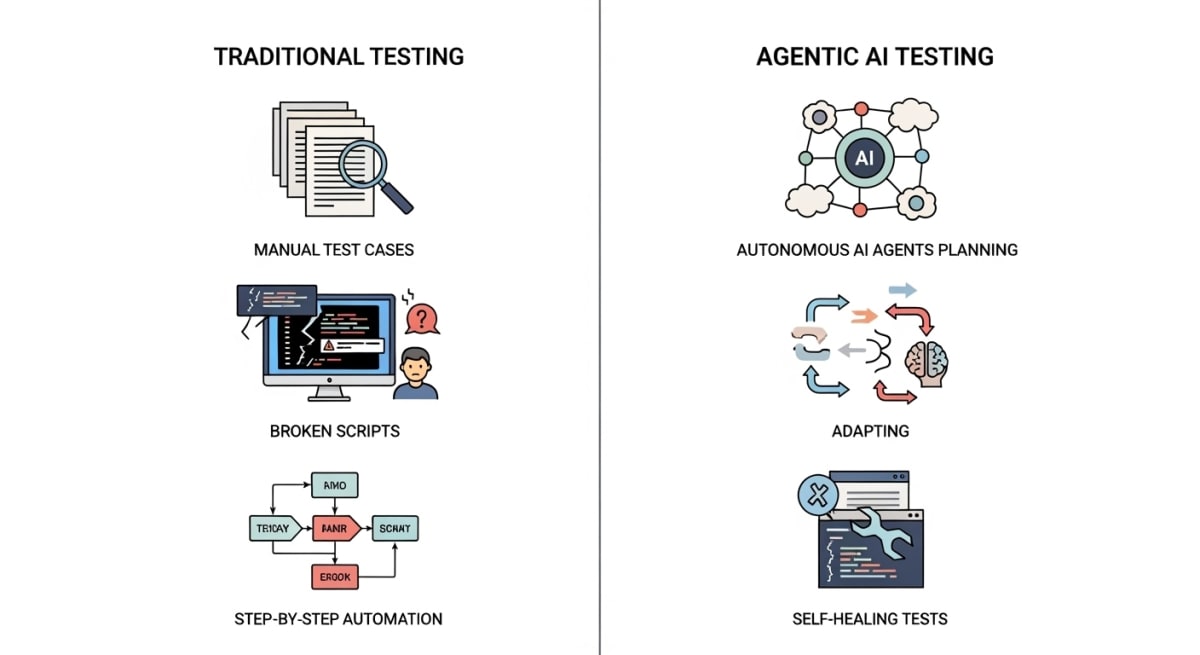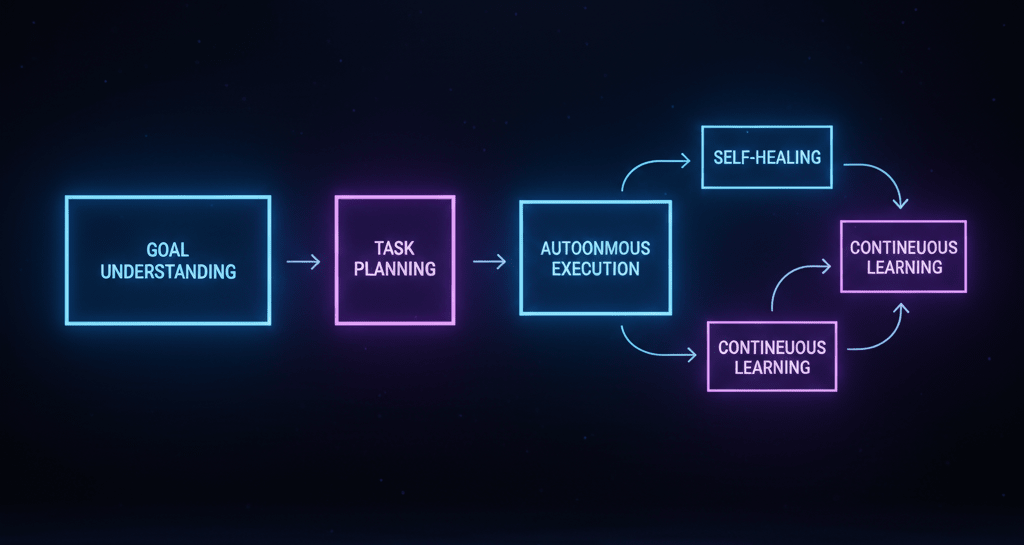How Agentic AI Is Redefining the Role of Testers: A Deep Educational Guide

Software testing has always evolved alongside the technologies it protects. From manual testing to early automation frameworks and eventually full CI/CD pipelines, every era has pushed testers to expand their skills and rethink their responsibilities. Today, the industry stands at another major turning point the rise of Agentic AI.
Unlike traditional automation, which executes predefined steps, Agentic AI introduces a fundamentally new capability: autonomous intelligence. These AI systems can observe applications, interpret high-level goals, plan tasks, adapt to unexpected changes, and execute actions without human-written step-by-step instructions. For testers, this doesn’t just shift the testing landscape it redesigns it from the ground up.
This educational guide will break down what Agentic AI really is, how it transforms QA workflows, what opportunities it creates, and the new responsibilities testers must embrace. Everything here is grounded in capabilities already emerging in AI-powered test engineering, without exaggeration or speculative claims.
1. Understanding Agentic AI: The Next Frontier of Testing
Agentic AI refers to AI systems capable of autonomous decision-making. Instead of simply following scripts or reacting to predefined triggers, agentic models can:
Interpret a goal (e.g., “test this checkout flow”)
Break it into logical steps
Examine the system under test
Decide which test paths make sense
Adapt when something unexpected happens
Learn from failures or application changes
This behavior mimics how human testers reason:
“What should happen here?”
“What scenarios could break this feature?”
“What if the UI changes?”
“What path should I explore next?”
Traditional testing automation is static. Agentic AI is adaptive.
Why This Matters for Testers
Agentic AI doesn’t try to replace human testers. Instead, it handles the labor-heavy, repetitive, or reactive tasks allowing testers to move into more strategic, analytical, and creative roles.
2. Traditional Automation vs. Agentic AI: What’s the Real Difference?

To understand the shift, let’s compare how both approaches behave in real testing environments.
Traditional Automation
Executes pre-written scripts
Fails when UI changes
Cannot make decisions
Needs constant maintenance
Depends heavily on test engineers to “tell it what to do”
Agentic AI
Understands goals instead of scripts
Adjusts when elements change
Makes decisions dynamically (e.g., handle pop-ups, alternative paths)
Learns from past runs
Generates new tests from documentation, UI, and user behavior
The difference is thinking vs. following commands.
3. How Agentic AI Is Transforming Test Automation
The impact of Agentic AI on test engineering can already be seen in five major areas.
a) Autonomous Test Case Generation
One of the biggest time drains for testers is reading requirements, understanding business logic, and converting them into actionable test cases.
Agentic AI can:
Analyze requirement documents
Study Figma or UI design files
Inspect user flows
Recognize input fields, buttons, and workflows
Automatically create relevant test cases
This mirrors how a human tester asks:
“What is the user expected to do here, and what needs to be validated?”
Instead of generating thousands of flaky tests, agentic systems focus on context-aware, meaningful tests.
b) Intelligent Test Maintenance (Self-Healing)
Every tester knows the pain of:
Broken locators
Changing UI layouts
Modified workflows
Updated component names
Deleted elements
Traditional automation simply breaks.
Agentic AI, however, can:
Detect element changes
Map new UI components
Repair test steps automatically
Suggest updated scripts when required
Re-run tests to validate the fix
This reduces hours of script maintenance into minutes of automated correction.
c) Dynamic Decision-Making During Test Execution
This is where Agentic AI truly becomes “agentic.”
Instead of failing when an unexpected scenario appears, it can:
Recognize unplanned pop-ups
Navigate around unstable UI elements
Choose alternate paths
Reattempt blocked actions
Skip irrelevant screens and continue testing
This is very similar to how an experienced tester behaves:
“If this error appears, I’ll close it and continue checking the main flow.”
AI agents don’t panic they adapt.
d) Improved Test Coverage Through Intelligent Exploration
Testers often operate under time pressure:
Limited regression cycles
Short sprints
Multiple features shipping at once
Agentic AI agents can perform autonomous exploratory testing, identifying:
Edge cases
Misaligned UI states
Inconsistent responses
Rare failures
Non-documented behaviors
They can map user flows the team didn’t even know existed.
This leads to:
Fewer escaped defects
Higher product quality
More stable releases
e) Support for Shift-Left and Shift-Right Testing
Modern testing is no longer about “testing at the end.”
Agentic AI integrates across the SDLC:
Shift-Left
Analyzes pull requests
Suggests test scenarios early
Runs tests in CI pipelines
Highlights areas of risk before merging
Shift-Right
Observes production logs
Extracts real user journeys
Generates test cases based on actual usage patterns
Detects anomalies from live interactions
This makes testing continuous, contextual, and data-driven.
4. How Agentic AI Changes the Tester’s Daily Workflow

Agentic AI changes not just the tools testers use but the nature of their work.
Here’s what a typical tester often handles today:
Reading requirements
Writing manual test cases
Updating scripts
Running regression suites
Logging bugs
Re-testing fixes
Maintaining automation frameworks
Now compare that to a future workflow with Agentic AI:
Tasks Handled by AI
Test case creation
Script maintenance
Regression execution
Environment setup
Real-time adaptation
Documentation updates
Exploratory testing at scale
Tasks Handled by Testers
Understanding business logic
Prioritizing what matters
Designing test strategies
Validating AI decisions
Exploring creative scenarios
Assessing user experience
Communicating risks
The Benefits
Lower manual workload
Reduced tester burnout
Higher test coverage
Faster feedback loops
More intelligent discussions with developers
More time to focus on quality, not clicks
Agentic AI doesn’t replace testers it elevates them.
5. New Skills Testers Need in the Age of Agentic AI
As AI takes over repetitive work, testers evolve into AI-guided quality engineers.
Here are the skills that will matter most:
a) Deep Domain Understanding
AI can analyze patterns, but it doesn’t know:
Business priorities
Regulatory constraints
Real customer expectations
Critical vs. low-risk scenarios
Testers who understand the product deeply become invaluable.
b) Test Strategy Design
Agentic AI can execute, but it still needs direction.
Testers must decide:
What features matter most
Which risks carry the highest impact
What level of coverage is acceptable
Which areas need human exploration
AI needs a strategy to execute against.
c) Critical Thinking and Human Judgment
AI may misinterpret certain scenarios. Testers must:
Evaluate whether AI-generated tests make sense
Validate that AI’s decisions are logical
Distinguish between real issues and false positives
Human intuition remains irreplaceable.

d) AI Tool Awareness
Testers don’t need to become ML experts, but they must:
Understand how agentic testing tools work
Know how to configure goals and constraints
Supervise AI performance
Interpret AI-generated reports
This is similar to how testers once had to learn Selenium or Cypress.
e) Strong Communication Skills
AI can generate logs, screenshots, or flow diagrams, but testers must communicate:
Risks
Insights
Testing outcomes
Release confidence levels
Cross-functional clarity becomes more important than ever.
6. The Limitations of Agentic AI (and Why Testers Still Matter)
Agentic AI is powerful but it is not perfect. It has real constraints testers must be aware of.
a) Limited Business Context
AI may not understand:
Legal constraints
Business priorities
UX expectations
Cultural nuances
It can operate the system, but it doesn’t “understand” the why.
b) Decision Transparency
AI can make choices that seem correct but are not fully explainable.
Testers must ensure the AI’s decisions align with the test strategy.
c) Over-reliance on AI
There is a risk of teams becoming passive:
Letting AI generate all tests
Ignoring exploratory testing
Assuming AI “understands everything”
Human involvement remains essential.
d) Potential for Misinterpretation
AI may incorrectly categorize:
Expected vs. unexpected behaviors
True vs. false failures
Critical vs. trivial issues
Human testers anchor the process with real-world understanding.
7. The Future of Testing: A Collaboration Between Humans and AI

Agentic AI is not a replacement for testers it is a co-tester.
A tireless assistant.
A force multiplier.
Testers who embrace it will:
Spend less time on busywork
Gain more time for creativity
Make more strategic contributions
Influence product quality more deeply
The testers who thrive will be:
Curious
Adaptive
Analytical
Business-focused
AI-aware
As AI handles the execution, testers become quality leaders, strategists, and product thinkers.
Final Thoughts
Agentic AI represents one of the biggest shifts in the history of software testing. It doesn’t just automate it thinks, plans, adapts, and learns. This transformation opens the door for testers to move away from repetitive tasks and toward high-level quality engineering work.
The future of testing is not about choosing between humans or AI.
The future is humans + AI, working together.
Testers who embrace agentic systems will lead the next era of software quality an era defined by speed, intelligence, adaptability, and continuous improvement.
Join the conversation
Sign in to share your thoughts and engage with other readers.
No comments yet
Be the first to share your thoughts!